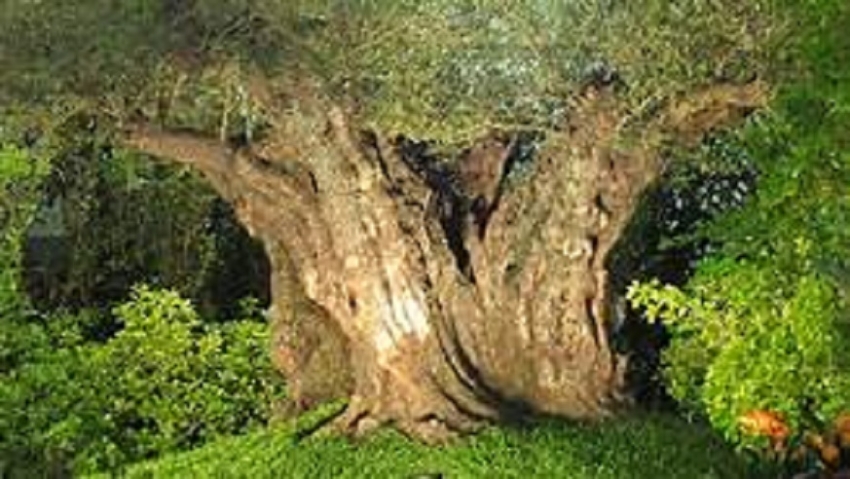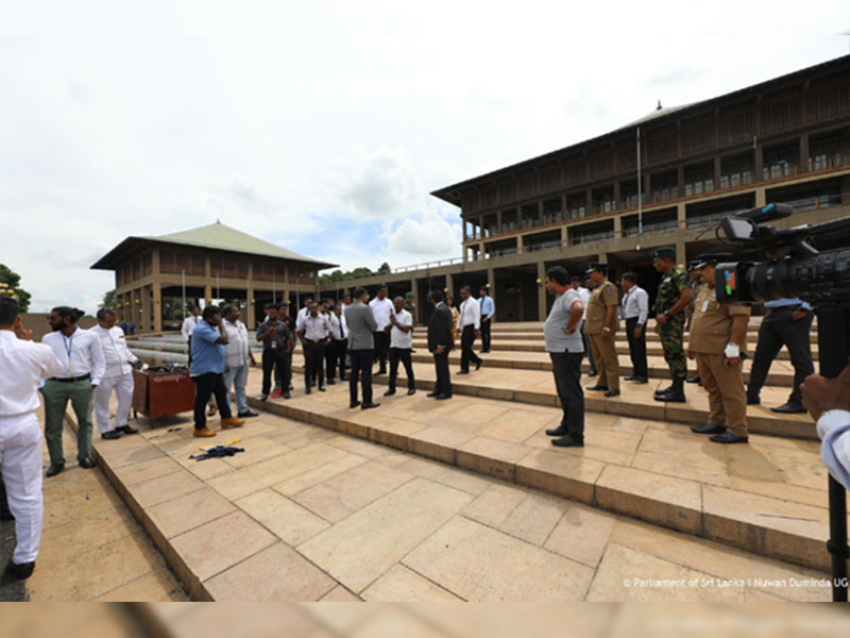At his laboratory in a wooded grove in northern Kyoto, Takeshi Nakatsuka holds up a vacuum sealed bag. Inside, bobbing in a bath of brown water, is a glistening disk the size of a dinner plate and the color of rich gravy. This soggy circle is the remnants of a 2,800-3,000-year-old tree, recovered from a wetland – water included, so the spongy wood does not deform – in Japan’s Shimane Prefecture, just north of Hiroshima. Within this ancient trunk lie secrets that can help us prepare for the future.
Nakatsuka, a palaeoclimatologist at Japan’s Research Institute for Humanity and Nature, along with a diverse team of 68 collaborators, has spent the last decade developing a novel method to reveal bygone precipitation patterns and interpret their effect on society. The results offer unprecedented insight into 2,600 years of Japanese rainfall patterns. By teasing out information locked inside the preserved wood of ancient forests, they are able to reveal just how much rain fell around the country over the past two and half millennia. It is an extraordinary record.
You might also like:
• Japan’s eerily hyper-realistic masks
• Why Japan’s stations are bathed in blue
• The plight of Japan’s modern hermits
About every 400 years, the researchers found, the amount of rain falling on Japan would suddenly become extremely variable for a period. The nation would toggle between multi-decadal bouts of flood-inducing wetness and warmer, drier years that were favorable for rice cultivation. As the rains came and went, Japanese society prospered or suffered accordingly.
Takeshi Nakatsuka with a 2,800-3,000 year old tree stump (Credit: Rachel Nuwer)
Palaeoclimatologist Takeshi Nakatsuka is using information preserved inside ancient tree stumps to learn about Japan's climate in the past (Credit: Rachel Nuwer)
“Multi-decadal variability provides us with the chance to transform as well as the chance to collapse,” Nakatsuka says. Regardless of the outcome, he emphasises that such change caused large amounts of stress for the people who lived through it.
As weather patterns today increasingly defy expectations, this window into past climate variability hints at what may be in store for us in the coming years
As weather patterns today increasingly defy expectations and extreme events become more frequent and severe, this window into past climate variability hints at what may be in store for us in the coming years. “Today is not different than 1,000 or 2,000 years ago,” Nakatsuka says. “We still have the same lifespans and we are still facing large, stressful multi-decadal variation.”
Nakatsuka builds a picture of what happened in the past using a number of proxies, including tree rings, corals, stalagmites, ice cores and sediment. But his latest findings, which he and his colleagues are currently preparing for publication, primarily rely on a new method that uses isotope ratios contained within wood to estimate precipitation patterns.
Central Japan is a perfect location for such a study because of the multitude of hinoki, a type of long-lived cypress. Nakatsuka’s study includes data from 68 hinoki, whose samples he sourced from living trees, buried logs, wooden temples, coffin boards and more. All of the wood ranged in age from 100 to 1,000 years.
The ratio of oxygen isotopes in the tree rings within the wood help to link it to environmental conditions in which it grew. On dry days, leaves lose more water and are left with a higher isotope ratio than on wetter ones, helping to give information about the relative humidity in the atmosphere.
“This is a very simple but very strict relationship,” Nakatsuka says. Modern meteorological databases confirmed that the isotope ratios of the most recently-lived trees in his dataset did indeed provide an accurate read on summer precipitation.
Japanese cypress trees (Credit: Getty Images)
Hinoki, a type of long-lived cypress that grows in many parts of central Japan, record the yearly changes in rainfall (Credit: Getty Images)
Isotope signatures, it turns out, also serve as time’s fingerprints: they are unique to the year in which they were created. Nakatsuka worked backwards, starting from a living tree whose age he knew. He used archeological and historic clues to approximate the centuries in which new tree samples lived. He then lined up their individual isotope signatures with other trees in his database that lived around the same time until he found the matching, overlapping pattern they shared. In this way, he stitched together a cohesive timeline from 600 BC to 2000 AD, creating a master chronology.
“Every tree in the master chronology is connected to the present,” Nakatsuka says. “It’s very accurate but time consuming and extensive work compared to traditional tree ring studies.”
While his timeline was able to reveal the erratic rise and fall of precipitation levels every 400 years or so, it didn’t tell Nakatsuka anything about what caused these oscillating patterns. The changes in rainfall he saw occurring every few decades closely matched previous data from conventional tree ring studies, though, and the multi-centurial and millennial patterns also lined up well with many previous reconstructions of past temperature fluctuations in East Asia and the world.
Collaborating with archaeologists and historians, Nakatsuka has been able to unravel what effect these changes in rainfall had on the people who lived at the time. Rainfall patterns over shorter and longer timescales corresponded, for example, to medieval ceremonies led by celebrity priests who prayed for rain. The development of irrigation systems and cooperative groundwater technologies meant to protect against drought also occurred at times when his record showed rainfall was low. As did the creation of government policies designed to rescue subjects from starvation during periods of famine. Most importantly, multi-decadal rainfall fluctuation neatly bookended major epochs in Japanese and Chinese history.
We archaeologists thought of the state formation process mainly in terms of social change, but now we can understand that floods are the background of such social change – Kunihiko Wakabayashi
“Before Nakatsuka’s analysis, we archaeologists thought of the state formation process mainly in terms of social change,” says Kunihiko Wakabayashi, a prehistorical archeologist at Doshisha University in Kyoto, who studies distributions of ancient human habitats around Osaka. “But now we can understand that floods are the background of such social changes.”
During the Yayoi period (1000 BC to 350 AD), for example, most human settlements near the Yoda River in Central Japan occurred in lowland delta areas. Rice cultivation began at that time and became a central part of life. People built peat homes alongside small rice paddies and tended to their plots individually. If waters shifted, people simply moved their homes to a nearby site, avoiding any large-scale upheaval.
A graduate student slices wood into thin samples (Credit: Rachel Nuwer)
By slicing the wood into thin samples, the researchers can extract cellulose for isotope analysis (Credit: Rachel Nuwer)
Around 100 BC, however, things began to change. The temperature dropped and rain increased. More and more people began to relocate further and further uphill—a sign, Wakabayashi says, of social confusion caused by frequent floods. The 5th century especially was marked by “a very unnatural, extreme movement of settlements up into the mountains,” Wakabayashi says.
Japan: Untold Stories
Welcome to BBC Future Now's Japan season, in which we explore the country's most exciting medical, technological, environmental and social trends.
You can discover:
The samurai swordsmith designing a spaceprobe
Why 'flammable ice' may solve an energy crisis
Ikumen: The rise of Japan's 'hunky dads'
The 'cathedral' protecting Tokyo from floods
And much more here.
By the beginning of the Kofun era (3rd to 6th Centuries AD), hardly any homes were left in the valley. Climate change was the catalyst that drove this process, but social factors quickly emerged as a result and created added layers of change.
“Local chiefs used environmental crises to rearrange social structures,” Wakabayashi says. Rice paddies, for example, began to be managed by chiefs. The people who worked those larger fields no longer lived adjacent to them, but uphill from their plots, and they no longer were the sole beneficiaries of their labours. A specialised class of ironworkers emerged and huge, 200-meter long tombs began to be erected, marking a sharp deviation from the small family plots that came before and an indicator of the social hierarchy emerging in Japanese society.
As the rains finally subsided in the 7th Century, people began to move back downhill and entered into the Asuka period, in which Buddhism was introduced, laws were created and Japan’s early state was formed.
Ancient history leaves few written traces, but more recent years are marked by increasing numbers of correspondences and records that historians can use to track climate-driven social fluctuations. Given Japan’s high past literacy rates and generations-long family systems, it is a gold mine for documents dating back to the 8th century. During the Tokugawa period (1603 to 1867), for example, historic documents tell us that Japan ran on an agricultural economy. Peasants paid taxes in rice and the Dojima Rice Exchange, a central market where brokers auctioned rice to merchants, sprang up in Osaka.
The stone chamber of Ishibutai Kofun (Credit: Getty Images)
Between the 3rd and 6th Centuries AD, large tombs known as Kofun began appearing as the social hierarchies in Japan changed (Credit: Getty Images)
Yasuo Takatsuki, an economic historian at Kobe University who studies economic barometers of early modern Japanese society, often scours specialised bookstores in Tokyo and Osaka for the centuries-old certificates – each of which represented 1,500 kg of rice – that resulted from sales at the Osaka auction house. The tickets show that prices over the Tokugawa period steadily declined, which lead to the world’s first known futures market.
“Local lords and the shogunate were very anxious about falling revenue, so they permitted speculation in the rice market based on derivatives,” Takatsuki says. “After that, anyone could join the market, including very small merchants.”
Most historians believe that Japan’s lack of population growth during the Tokugawa period created the excess supply of rice that led to its unique market. But Nakatsuka’s climate data indicate that favourable conditions for growing rice contributed much of the surplus behind the falling prices. “At that time, demand was stable and Japan had a closed economy, so only supply decided rice prices,” Takatsuki says. “And what decided the supply of rice? It’s climate, very clearly.”
Takatsuki also found that a one-off disaster – a flood that only impacted a single region of Japan, for example – did not influence rice prices or cause famine, but that blanket abnormalities across the entire country did. “In cases when the market economy failed to mitigate shocks from climate change, some speculators made big trades in derivatives, greatly exaggerating the price of rice,” Takatsuki says. Their eagerness to turn a profit at the expense of the population caused the Tokugawa shogunate to step in and restrict price fluctuations in order to save subjects from starvation. In some cases, the shogunate went so far as to throw certain traders in jail.
Researcher Li Zhen examines cellulose samples (Credit: Rachel Nuwer)
The samples examined by Nakatsuka's team have helped them to build up an unparrelled picture of rainfall over the past 2,600 years (Credit: Rachel Nuwer)
Knowledge of past weather conditions, Takatsuki says, “makes for a richer picture of history”—one that may also say something about how markets could respond to future shortages caused by climate change.
One resounding message that emerged from these and other findings, Nakatsuka says, is that people quickly become accustomed to favorable conditions. “If there’s a good stretch of just one to two years, people don’t adapt, they just thank the gods,” he says. “But if the favorable conditions continue over ten or twenty years, people increase their population, change their lifestyles and living standards, and get used to eating rice daily.”
When those good times abruptly come to an end, society cannot adapt. Devastation tends to ensure in the form of famine
But when those good times abruptly come to an end, he continues, society cannot adapt quickly enough. Devastation tends to ensue in the form of famine. Society also becomes more prone to conflict, especially if environmental impacts are not evenly distributed across the entire country, cleaving the population between haves and have-nots. Regional severe flooding in the late 13th and 14th Centuries, for example, sparked an upsurge in crime and local wars.
The world today, of course, is much more globalised and technologically savvy than that that of centuries ago. “Now, if the temperature drops, we can import rice from foreign countries and we don’t starve,” says Nakatsuka.
People in the rain in modern Japan (Credit: Getty Images)
Details about how Japan's people coped with changes in their climate in the past will provide clues about how they will deal with it in the future (Credit: Getty Images)
But we are still human beings, he continues, and we are still bound by the fact that change triggers stress, which in turn drives societal upheaval. Mounting discontent and fear over changing culture, demographics, climate and economies will likely only worsen in coming years, increasing the appeal of authoritarian, populist-style governance.
Nakatsuka and his colleagues believe history is spotted with many cases of multi-decadal-driven change. Some examples outside of their study are already known. Researchers in the US and Mongolia recently discovered, for instance, that Genghis Khan’s rise to power and conquest of China corresponded to a 15-year period of exceptional rainfall, which provided the great khan with the surplus livestock he needed to support an army. Nakatsuka and his colleagues hope that their project inspires others around the world to undertake similar investigations of the factors that determined whether bygone societies sank or swam in the face of climate change.
And as our current climate is expected to undergo unprecedented levels of change in the coming decades, the past may hold clues for what we should be preparing for.
“Human history includes many examples from which we can extract common lessons relevant to contemporary global environmental change,” Nakatsuka says. “The lesson for us now is that we must prepare to reduce the damage.”




















